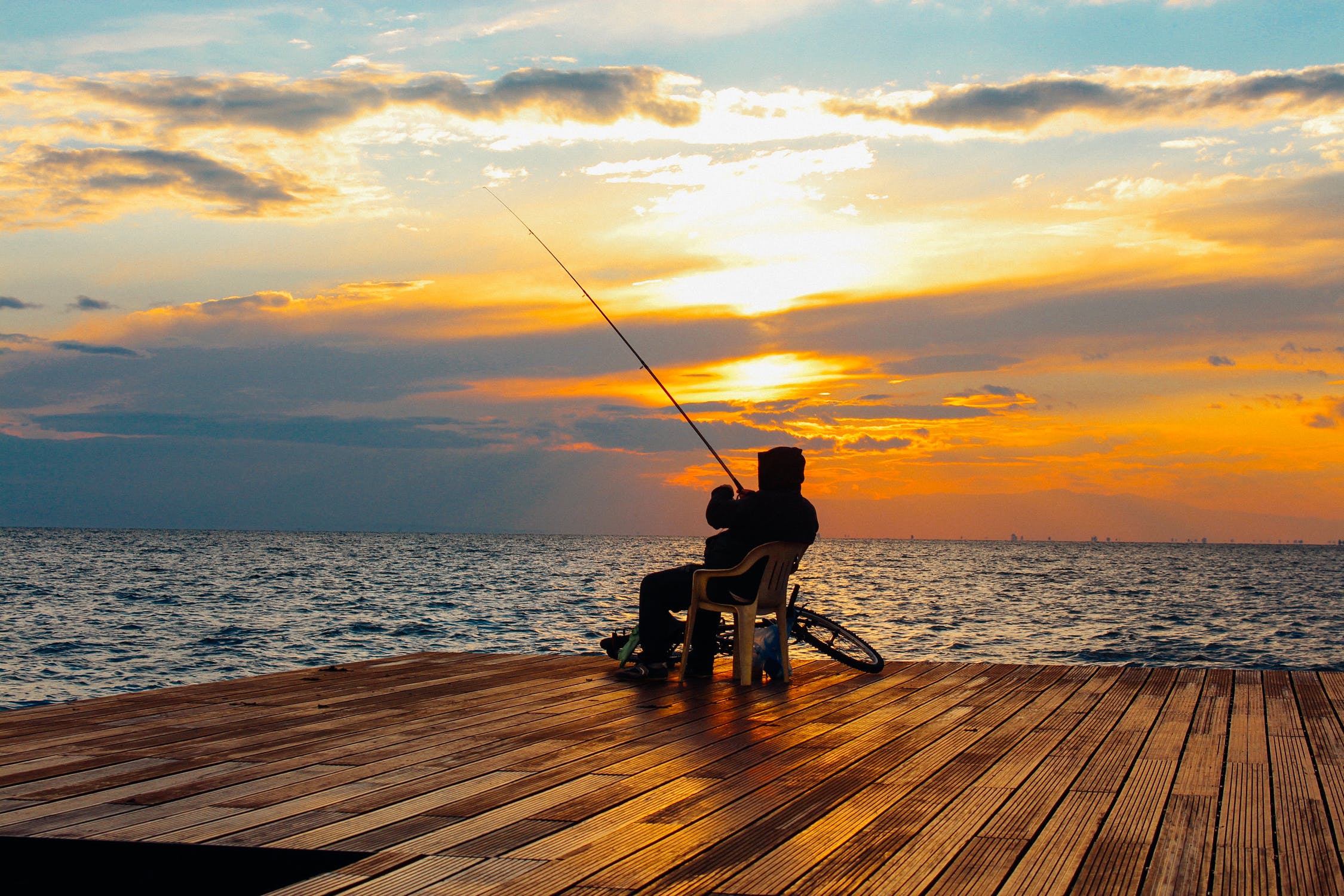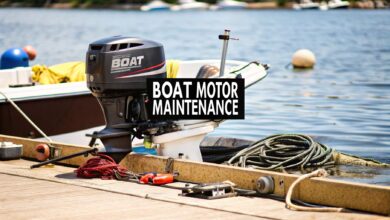
Learning to sail is really about one thing: figuring out how to make the wind your ally. This guide is here to help you do just that. We'll skip the fluff and get right into the practical side of things, moving you from someone who just admires boats from the shore to a sailor who feels confident at the helm.
Your Sailing Adventure Starts Here
Welcome aboard! There's a certain magic to sailing that goes far beyond just pretty pictures. It's about that incredible feeling of freedom and self-reliance you get when you're out on the water, working in harmony with the wind and waves. It’s a unique mix of peace and excitement.
We're going to cover everything you need to know to get started, from figuring out which way the wind is blowing to bringing the boat back to the dock without any drama. Think of this as the foundation for every sail you'll ever have. With a little practice, you'll be surprised how quickly it all starts to click.
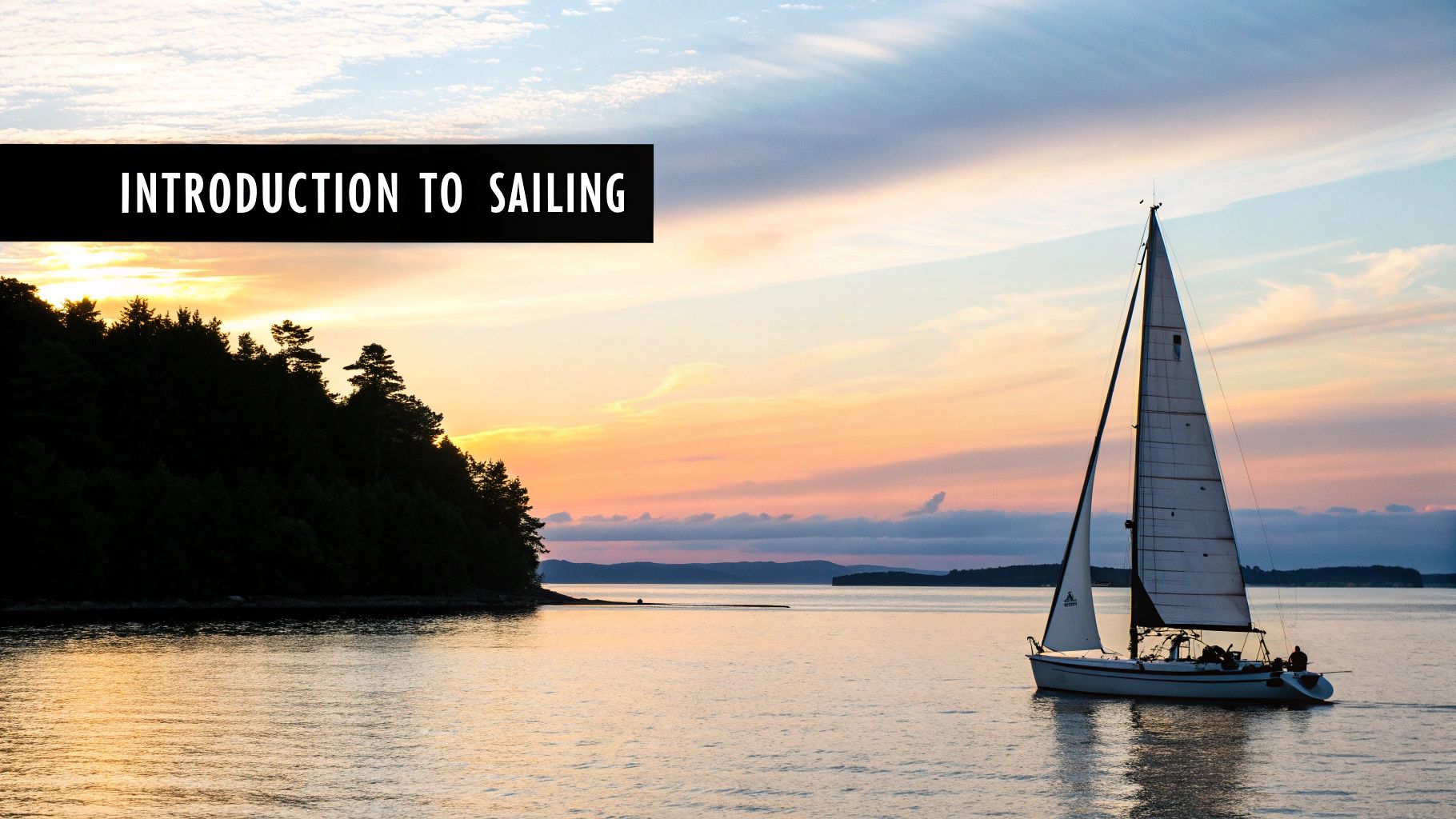
What to Expect on Your Journey
Don't worry, you don't need to memorize a dictionary of nautical terms before you even step on a boat. Real learning happens on the water, building an instinct for a few core principles that you’ll use every single time you sail. It’s part physical, part mental puzzle—a fantastic way to challenge yourself while also finding a bit of zen.
A lot of beginners are intimidated by the perceived complexity, but you can relax. Modern starter boats are built to be forgiving and easy to handle. It's much more about smart technique and a light touch than it is about raw strength. This guide will focus on the stuff that actually matters when you're just starting out.
"The sense of freedom the sea provides is unmatched. You spend a couple of hours sailing, head into the next spot, explore, and then decide where the wind will take you next."
Sailing Is More Accessible Than You Might Think
If you're getting into sailing now, you're in good company. The sailboat market has been growing steadily, which tells you something important: this isn't some exclusive, out-of-reach hobby anymore.
More and more people are discovering the joy of being on the water, thanks in large part to the boom in sailing schools and charter companies that make it easy to get started. You can dig into the specifics of this trend in the full sailboat market analysis report on Globenewswire.com.
Core Skills for Your First Day on the Water
To get you started on the right foot, it helps to know what you should be focusing on. These are the essential building blocks that will give you the confidence to handle a small sailboat in decent weather. Think of it as your day-one checklist.
| Core Skill | What It Means | Why It's Essential for Beginners |
|---|---|---|
| Understanding Wind Direction | Learning to feel and see where the wind is coming from. | This is the #1 skill in sailing. Everything else you do depends on knowing your relationship to the wind. |
| Basic Sail Trim | Adjusting the sails (letting them in or out) to catch the wind properly. | This is your engine. Proper trim gives you power and control, preventing you from just drifting aimlessly. |
| Steering with a Tiller | Using the tiller to point the boat where you want it to go. | It’s incredibly responsive. Learning a gentle touch on the tiller is key to smooth, controlled sailing. |
| Essential Maneuvers | Safely executing the two main turns: tacking (turning through the wind) and gybing (turning with the wind). | These are how you change direction. Knowing how and when to do them safely is non-negotiable. |
| Fundamental Safety | Knowing basic right-of-way rules and how to use your PFD (Personal Flotation Device). | Sailing is safe when you're prepared. This keeps you and everyone around you out of trouble. |
Mastering these fundamentals is the goal. We’ll tackle each of these in order, building your skills one step at a time so you have a rock-solid base to grow from. Now, let’s get into the gear you’ll need.
Getting Geared Up and Knowing Your Sailboat
Before you can even think about casting off the lines, a little prep work on shore is essential. It’s not about dropping a ton of cash on specialized equipment, either. It’s about being smart, comfortable, and ready for whatever the wind and water throw at you. A great day of sailing starts long before you step on the boat; it begins with dressing correctly and getting a basic feel for the vessel you’re about to command.
One of the first lessons in sailing has nothing to do with ropes or wind. It’s about the weather. It is always cooler on the water. Always. The golden rule is to dress for the temperature on land, and then add one more layer. Trust me on this. Conditions can shift in a heartbeat, and you’ll want fabrics that dry quickly. Synthetics and wool are your best friends here; leave the cotton at home, as it just gets wet, stays wet, and saps your warmth.
Your Essential Onboard Kit
You don’t need to pack a giant sea bag for your first few times out. Just a few key pieces of gear will make the difference between a fantastic day of learning and a miserable one. When you’re comfortable, you can focus on the important stuff—like not sailing into the dock.
- Non-Slip Deck Shoes: This is non-negotiable. Decks get wet, it’s a fact of life. You absolutely need shoes with soft, light-colored soles that provide serious grip. A good pair of sneakers with solid traction will do the trick when you're starting out.
- Layered Clothing: Think in threes: a base layer, a fleece or other mid-layer for warmth, and a waterproof or windproof shell. This combo will have you covered for almost any weather you’ll encounter on a day sail. It’s a lot easier to take a layer off than to shiver and wish you had one.
- Sun Protection: The sun reflecting off the water is no joke—it can be incredibly intense. A wide-brimmed hat, polarized sunglasses (they cut the glare dramatically), and sunscreen are must-haves, even if it looks cloudy.
- Sailing Gloves: Are they absolutely necessary on day one? No. But will your hands thank you for them? Yes. A simple pair of fingerless sailing gloves will save you from a world of rope burn and blisters as you start handling the lines.
I’ve seen it a thousand times: new sailors completely underestimating the elements. The same wind that fills your sails is constantly pulling away your body heat, and that beautiful sun is twice as strong when it’s bouncing off the water. Being prepared isn’t just a good idea; it’s the foundation of a great day.
Eventually, you'll accumulate more specialized gear, especially if you get your own boat. When that time comes, our guide on how to buy the right sailboat can help you figure out what to look for.
Getting to Know Your Vessel
Alright, let's step aboard. At first glance, a sailboat can look like a complicated mess of ropes, poles, and weirdly named parts. But once you break it down, the core components are actually pretty logical. Understanding what each part does is the key to making the boat go where you want it to.
Here’s a quick tour of your new playground. We’ll focus on the "why" behind each piece so the terms make sense and actually stick.
- Hull: Simply put, this is the body of the boat. Its shape is what allows it to slice through the water.
- Mast: That big, tall pole sticking straight up. Its job is to hold the sails up.
- Boom: The horizontal pole connected to the mast. Heads up! This is the one you have to watch out for. The boom swings across the boat during a turn, so you always need to know where it is.
- Rudder: This is the fin underwater at the very back (the stern). It’s how you steer, controlled by either a tiller (a long stick) or a wheel.
Think of the sails as your engine and the ropes—which we call “lines” on a boat—as your throttle and steering wheel. On most boats you'll start on, there are two main sails: the mainsail (the big one behind the mast) and the jib (the smaller one out front).
The Ropes That Run the Show
You'll hear the lines that control the sails called "sheets." Pulling a sheet in is called "trimming" or "sheeting in," and it powers up the sail. Letting it out, or "easing," does the opposite, reducing the power.
You'll be working with two main ones all the time:
- Mainsheet: This line controls the mainsail, managing its angle to the wind and how much power it generates.
- Jib Sheets: These come in a pair, one for each side of the boat. They do the same job as the mainsheet, but for the jib.
Getting your hands on these lines and feeling how they affect the boat is what turns an unfamiliar machine into something that feels like an extension of yourself. This learning process is getting easier all the time. North America is a huge hub for the sailing industry, driven by a massive community of recreational boaters and the quick adoption of new technology in sailing schools. Modern tools like smart navigation apps are making it simpler than ever for beginners to grasp wind dynamics, boat handling, and safety from their very first day on the water. You can actually see how technology is shaping modern sailing on Peekpro.com.
How to Read the Wind and Rig Your Boat

In sailing, the wind is your engine. It's your fuel and your guide, all in one. Every single thing you do on the water, from how you set your sails to the way you steer, is a direct response to what the wind is doing. Learning to read its signs is probably the most important skill you can develop as a sailor. It’s less of a science and more of an art form you’ll cultivate over time.
Forget about complex weather charts for a moment. Start with the basics: feel the wind on your face and watch the surface of the water. Is it glassy and calm? Or do you see little ripples, what we call cat's paws, skittering across it? These visual cues are your most immediate and reliable source of information.
Finding Your Wind Direction
Before you can harness the wind, you have to know where it's coming from. This becomes your constant point of reference. Even the most seasoned sailors are constantly checking and re-checking the wind.
Here are a few simple, field-tested ways to find the wind:
- Use Your Senses: The oldest trick in the book. Turn your head from side to side until you feel the breeze equally on both ears. When you do, you're looking directly into the wind.
- Watch the Water: Ripples and small waves always move in the same direction as the wind. Just watch how they travel across the surface.
- Look Ashore: Flags, smoke from a chimney, or even the way trees are bending on the shoreline are all excellent clues to the wind's path.
- Check Your Telltales: Those little pieces of yarn or ribbon on your sails are called telltales, and they are your best friend. They stream back, showing you exactly how the wind is flowing over the curve of your sails.
A classic beginner mistake is getting "tunnel vision"—staring only at the sails or the tiller. You have to train yourself to constantly look around: at the water, at flags on shore, and up at your telltales. The wind is a living thing, always shifting, and your awareness needs to shift right along with it.
Your Guide to the Points of Sail
Once you know the wind’s direction, you can orient your boat in relation to it. This angle between your boat and the wind is called your point of sail. There are a few key points, but it's better to think of them as general zones rather than exact, scientific degrees.
Let's imagine the wind is coming from the 12 o'clock position on a clock face.
- In Irons (12 o'clock): This is the "no-sail zone." You can't sail directly into the wind; your sails will just flap uselessly, and the boat will stop.
- Close-Hauled (1 & 11 o'clock): This is as close to the wind as you can possibly sail, usually around a 45-degree angle. Your sails will be pulled in tight.
- Beam Reach (3 & 9 o'clock): The wind hits the side (the "beam") of your boat. This is often the fastest, most efficient point of sail. Sails are let out about halfway.
- Broad Reach (4 & 8 o'clock): Now you're sailing away from the wind, with it coming over the back corner of the boat. Let those sails out even further.
- Running (6 o'clock): The wind is directly behind you, and your sails are out as far as they'll go. This can feel unstable for beginners, so approach this point of sail with a bit of caution.
The Pre-Flight Check: Rigging Your Boat
"Rigging" is just the nautical term for getting your boat ready to sail. Think of it as your pre-flight checklist, the process of turning a parked vessel into a seaworthy craft. It might look like a mess of ropes and clips at first, but it's a logical, repeatable process you'll soon master.
At its core, all you're doing is attaching the engine (the sails) to the boat's frame (the mast and boom). Every line has a specific job. You’ll attach the corners of the mainsail and jib to their designated spots, then run the sheets (the control lines) back to the cockpit where you can adjust them.
This is a foundational skill that applies whether you're on a tiny dinghy or a much larger vessel. In fact, the whole sailing community is growing, thanks in part to a surprisingly resilient luxury yacht market and better marina infrastructures. This creates more opportunities for everyone, from strengthening local sailing clubs to making professional instruction more accessible. You can discover more about the yacht market's steady growth online. Nailing this rigging process is your first real step toward becoming a confident sailor.
Mastering Tacking and Gybing
Alright, let's get to the really fun part—making the boat dance. Tacking and gybing are the two essential turns that will let you steer your sailboat anywhere you want to go. Think of them as the right and left turns of the sailing world. Once you get these down, you start to feel a real connection with the boat, turning abstract ideas like wind direction into graceful, deliberate motion across the water.
These maneuvers are your bread and butter. You'll use them for everything from a simple course correction to zig-zagging your way upwind. One is a fairly gentle turn through the breeze, while the other requires a healthy dose of respect and careful handling. Let's break down both so you know exactly what to do and when.
The Upwind Turn: Tacking
Tacking is your go-to move whenever you're sailing upwind. It’s the process of turning the bow of your boat through that "no-sail zone" (the area directly into the wind) to switch the wind from one side of the boat to the other. It's generally a smooth, controlled, and essential skill for making any progress against the wind.
Picture this: you need to reach a buoy that’s directly upwind from your current position. Since you can’t sail straight into the wind, your only option is to sail at an angle (close-hauled) and then tack to switch to the opposite angle. This creates a zig-zag pattern that lets you steadily chew up the distance to your destination.
Before you even think about turning, communication is everything. As the skipper, you need to announce your intentions clearly. The standard call is "Ready to tack?" to alert your crew. Once they give you the all-clear, you follow up with the command to execute: "Tacking!"
Here’s how the sequence plays out on the water:
- You’ll start by smoothly pushing the tiller away from you, which turns the boat’s bow toward and then through the wind.
- The moment the jib (the front sail) starts to luff and flap, that’s everyone's cue to move.
- Your crew—or you, if you're sailing solo—will release the working jib sheet and quickly pull in the new one on the opposite side.
- As the boom swings over to the new side, you’ll shift your weight, find your new spot, get the boat settled on its new course, and trim the sails.
A classic beginner mistake is turning either too slowly or way too fast. A sluggish turn can kill your momentum and leave you stuck "in irons" (stalled, facing the wind). A jerky, fast turn can throw everyone off balance. You're looking for a smooth, confident, and steady motion. Your boat has forward momentum—let it help you glide right through the maneuver.
The Downwind Turn: Gybing
Gybing (or jibing) is the polar opposite of tacking. This time, you’re turning the stern of your boat through the wind. This is the maneuver you'll use when sailing downwind and you need to change direction. While it achieves a similar goal—switching the side the wind is on—it demands a lot more caution.
The primary danger in a gybe comes from the boom. Because the wind is pushing from behind, it can slam the boom and mainsail across the boat with incredible force if it’s not controlled. A well-executed gybe is a thing of beauty; an uncontrolled one is genuinely dangerous.
The command sequence is just as critical here: "Ready to gybe?" followed by a clear "Gybing!" This gives everyone a heads-up to prepare for the boom's journey across the cockpit.
Here’s the step-by-step for a controlled gybe:
- Before initiating the turn, haul in the mainsheet. This brings the boom closer to the boat's centerline, dramatically reducing the distance it has to travel and reining in its momentum.
- Gently steer the boat into a slow, deliberate turn, pointing the stern through the eye of the wind.
- As the wind catches the back of the mainsail, the boom will swing across. Because you’ve already pulled in the mainsheet, its movement will be short and controlled, not a violent slam. Always keep your head down!
- Once the boom is safely on the new side, you can ease the mainsheet back out to the proper trim for your new downwind course.
This image highlights the ideal conditions for a beginner to practice in. Mastering these turns in lighter winds first is not just easier—it's much, much safer.
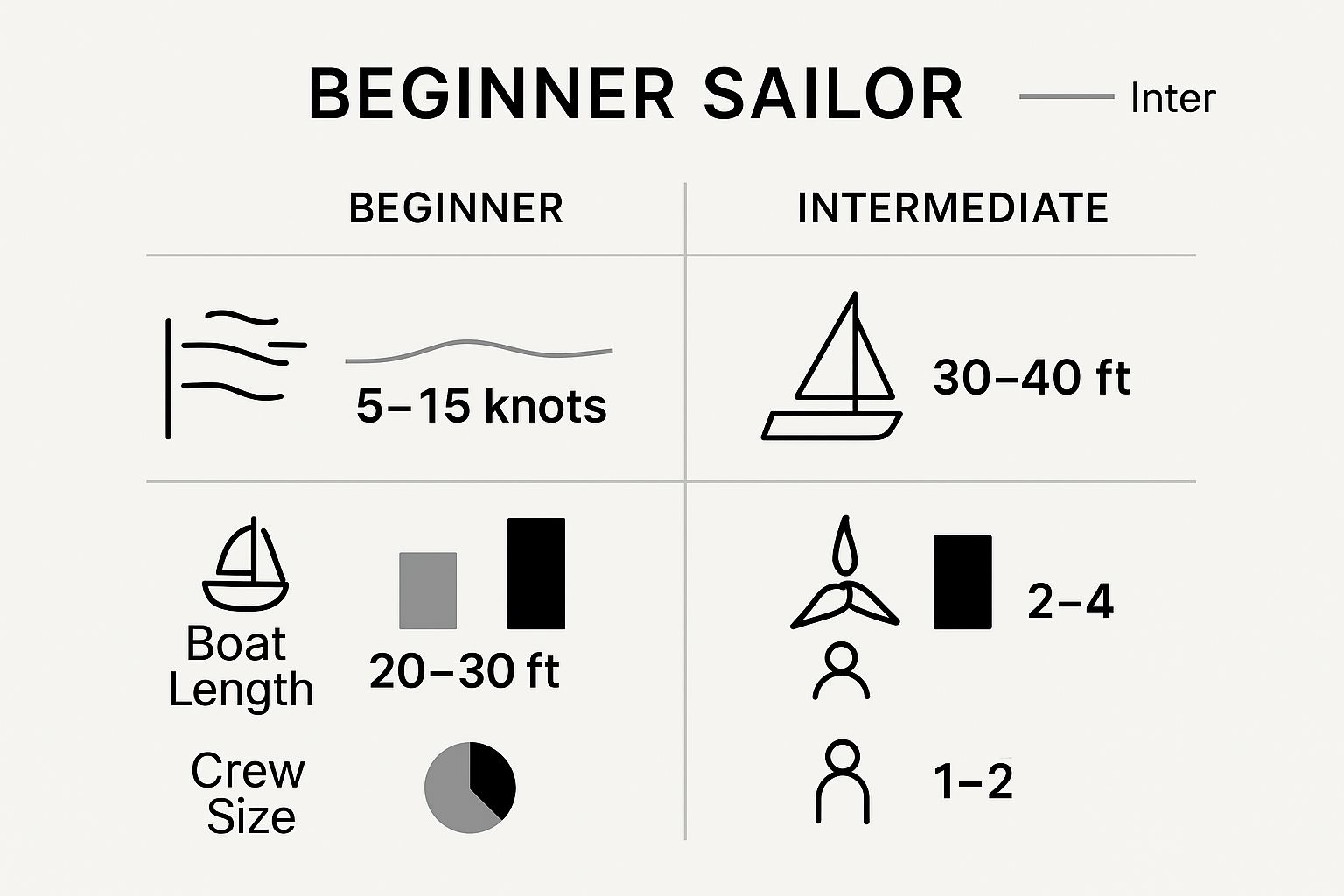
The data clearly shows that sticking to lighter winds and smaller boats creates a much more forgiving environment for learning maneuvers like tacking and gybing.
Tacking vs. Gybing at a Glance
So, when do you tack and when do you gybe? The answer depends entirely on your point of sail and where you want to end up. To help you keep it straight, here’s a quick comparison of the two maneuvers.
| Maneuver | Direction of Turn | Primary Use | Key Action | Beginner's Tip |
|---|---|---|---|---|
| Tacking | Bow turns through the wind. | Changing direction when sailing upwind. | Smoothly push the tiller away to steer into the wind. | Keep your speed up going into the turn to avoid getting stuck. |
| Gybing | Stern turns through the wind. | Changing direction when sailing downwind. | Control the boom by pulling in the mainsheet before you turn. | Practice in light winds first to build confidence. Never let the boom swing uncontrolled. |
In the end, tacking is generally considered the safer and easier of the two turns, and it’s something you’ll do over and over again on your first few trips. Gybing demands respect and solid technique, but with a bit of practice, it will become just as routine. Both are essential tools in your sailing for beginners toolkit, giving you the freedom to explore the water with true confidence.
Docking and Departing with Confidence
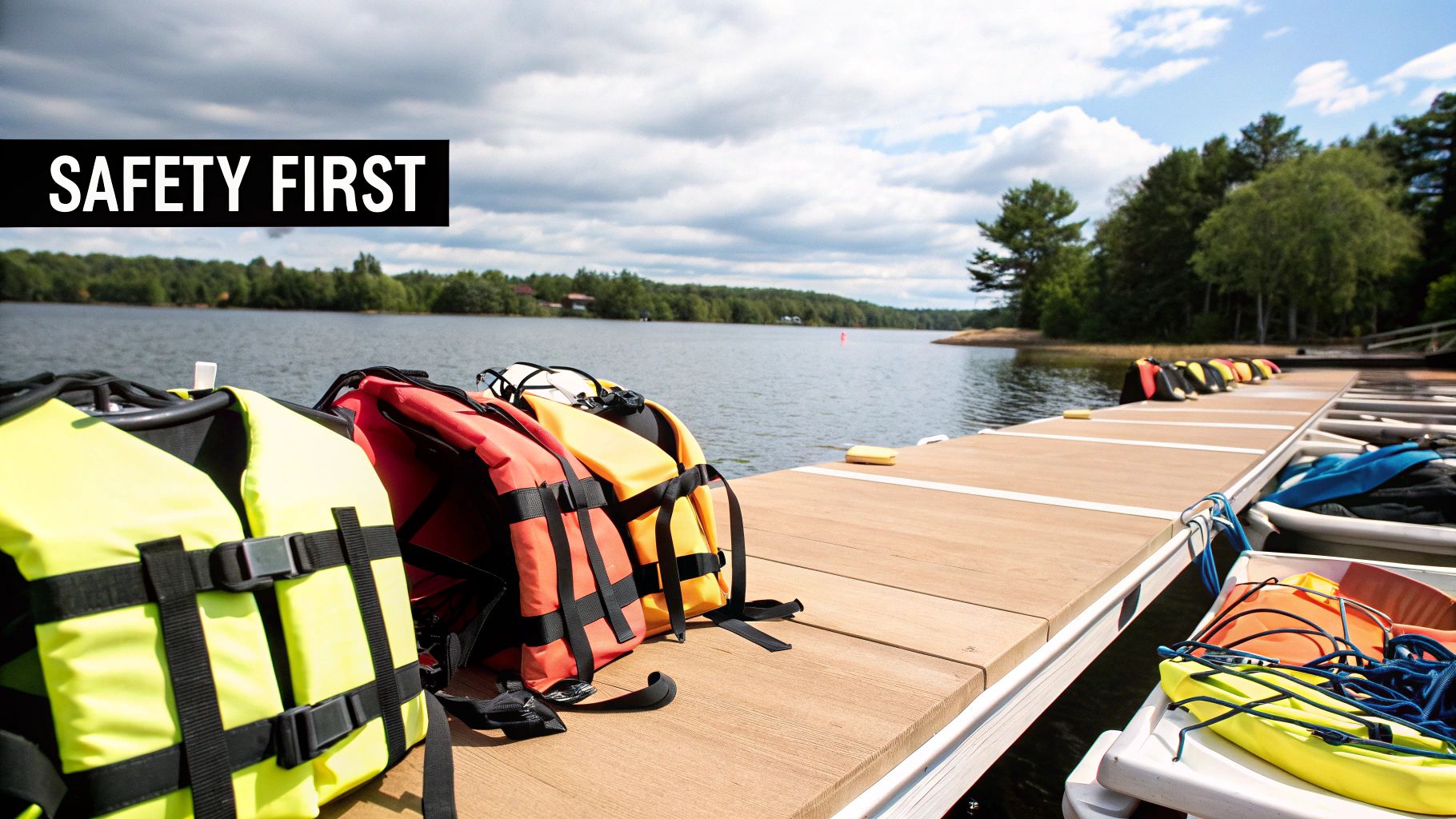
For a lot of new sailors, the most nerve-wracking part of a day on the water isn’t handling the wind or the waves—it’s those first and last five minutes. Leaving and returning to the dock can feel like a final exam with an audience. But I can tell you from experience, the secret to swapping that anxiety for confidence is simple: slow everything down, think ahead, and make the elements work for you.
Making a Clean Getaway
A smooth departure starts long before you untie a single line. First things first, take a look around. Which way is the wind blowing? Is there a current? These forces are either your best friend or your biggest obstacle, so figure out what they're doing to your boat.
If the wind is blowing you off the dock, you're in luck. That's the easiest scenario. Once your lines are clear, the wind will naturally push you out into open water with minimal effort. Just be ready to steer.
But what if the wind is pinning you against the dock? This calls for a bit more finesse. A great trick is to use a spring line—a line from the bow or stern that acts as a pivot. This lets you use your engine to angle one end of the boat out and away from the dock before you cast off that final line.
Before you let go, run through a quick pre-flight check in your head:
- Fenders In: Are all your fenders onboard? Leaving one hanging is a surefire way to get it snagged.
- Lines Ready: Are the dock lines you'll need later coiled and stowed neatly, not in a tangled mess?
- Crew Briefed: Does everyone know the plan? Who is handling which line?
- Path Clear: Is your exit route free of other boats, kayaks, or swimmers?
A calm, confident departure is 90% preparation and only 10% execution. The more you prepare on the dock, the smoother things will go. Rushing is the number one cause of beginner mistakes.
The Art of the Approach
Coming back to the dock is all about controlling your speed. I tell every new sailor the same thing: never approach the dock faster than you're willing to hit it. Your goal is to glide into your spot and come to a gentle stop right where you want to be. It's a dance, not a race.
Start planning your approach while you’re still well away from the dock. Just like when you left, get a feel for the wind and current. Ideally, you want to head into the wind or current when you approach. This is a game-changer because it acts as a natural brake, giving you incredible low-speed control. Approaching with the wind at your back is a classic mistake that often ends with you coming in way too hot.
Get your fenders and lines ready to go long before you're anywhere near the dock. Put fenders at the widest part of your boat (the beam) and have at least one bow line and one stern line ready to be passed to someone on the dock or looped over a cleat. Communication with your crew is everything here—make sure they know which line is the most important to get on first.
If you want to get into the nitty-gritty of different docking scenarios, our comprehensive guide on how to dock a boat covers specific techniques in much more detail.
Once you’re tied up securely, take a breath and give yourself a pat on the back. You've just nailed one of the most intimidating skills in sailing. Every departure and arrival builds that muscle memory, turning a moment of stress into a point of pride. Mastering this truly makes you feel like you're in command of your vessel.
Essential Safety Rules for the Water
https://www.youtube.com/embed/I_mLfbUCQlM
Sailing is incredibly freeing, but that freedom comes with a healthy dose of responsibility. Being a safe sailor isn't about memorizing some dense rulebook; it’s about building good habits and a mindset of awareness before you even think about leaving the dock. When you’re prepared, you can relax and truly enjoy your time on the water.
Your number one piece of safety gear is always going to be your Personal Flotation Device (PFD). Forget those bulky, bright orange life jackets from your childhood summer camp. Today’s PFDs can be so lightweight and streamlined you'll forget you're even wearing one.
If you’re unsure which style is right for you, our guide on how to pick inflatable life vests is a great place to start. The rule of thumb I always follow is simple: if you have any doubt, put it on. For anyone just starting out, I’d recommend wearing it every single time you go out.
Nautical Rules of the Road
Just like driving a car, there's a system for avoiding traffic jams and collisions on the water. These "rules of the road" are thankfully pretty straightforward. The boat with the right of way is known as the stand-on vessel, while the boat that has to change course to avoid it is the give-way vessel.
When two sailboats meet, here's how you know who has the right of way:
- Opposite Tacks: If you're on a collision course and your sails are on opposite sides of your boats, the boat on the starboard tack gets to hold its course. That means the wind is coming over its right side, so its boom is out to the left. The other boat (on the port tack) must give way.
- Same Tack: What if you're both on the same tack, with your sails on the same side? In that case, the leeward boat—the one that's downwind from the other—has the right of way. The windward boat is responsible for keeping clear.
A simple way I learned to remember this is: "If the wind is on your right, you are in the right." This little rhyme covers the most common situation you’ll find yourself in. Still, always keep a lookout. Having the right of way doesn't protect you from someone who isn't paying attention.
Handling Unexpected Scenarios
Sooner or later, something won't go exactly to plan. That’s just part of sailing. The key is to stay calm and have a rough idea of what to do.
What if the wind just dies? Don't panic. It happens. This is a perfect chance to neatly drop your sails, pull out a snack, and just enjoy being on the water. The breeze almost always returns.
If you see storm clouds building on the horizon, the smart move is always to head for the harbor. Don't try to be a hero. If you do get caught in a blow, you'll want to reduce your sail area—a technique called reefing—which instantly makes the boat less overpowered and much easier to handle.
Finally, always keep a whistle or an air horn within easy reach. A few quick blasts are the universal signal for "Hey, I'm here!" and can be a lifesaver in fog or when another boat doesn't seem to see you. Mastering these simple safety basics is what turns sailing from something that feels a bit intimidating into a lifetime of adventure.
Answering Your First Sailing Questions
As you get ready to cast off for the first time, it's natural to have a few questions swirling around. Let's tackle some of the most common ones I hear from new sailors. Getting these sorted out will help you step onto the dock with more confidence and a clearer idea of what to expect.
How Long Will It Take to Learn to Sail?
You can get a handle on the absolute fundamentals—steering, basic sail trim, and how the boat feels—in just a weekend of good practice. The initial thrill of making the boat move with the wind can happen surprisingly fast.
But becoming truly competent, the kind of sailor who can confidently handle changing conditions or unfamiliar waters, takes a bit more time. A good benchmark is around 20-40 hours of solid, on-the-water experience. For most people, a full season of sailing regularly is what really cements the skills and builds true self-reliance.
Do I Need to Be Super Strong?
Absolutely not. This is probably the biggest myth in sailing. Modern sailboats are designed with brilliant systems of ropes, pulleys, and winches that give you a huge mechanical advantage. You're not wrestling the boat; you're using physics to your advantage.
Sailing is much more about finesse and understanding the wind than it is about brute force. It's a fantastic sport for people of all ages, sizes, and fitness levels. Technique will always beat pure strength.
Should I Learn From a Friend or Take a Course?
Going out with a friend is a fantastic, low-pressure way to see if you even enjoy being on a sailboat. But when it comes to learning properly, I always recommend a formal course.
Here’s why:
- Proven Methods: Certified instructors teach standardized, time-tested techniques for safety and efficient boat handling.
- Logical Progression: A course builds your skills from the ground up, making sure you don't miss any critical knowledge along the way.
- No Bad Habits: Learning from an expert helps you avoid picking up those common bad habits that can be a real pain to unlearn later on.
What's the Biggest Mistake Beginners Make?
Without a doubt, it's over-steering. New sailors often grip the tiller too tightly and make big, jerky movements, which just makes the boat zig-zag uncomfortably. The key is a light touch. Make small, subtle adjustments and feel how the boat responds before you do more.
The other classic rookie error is losing track of the wind. Your awareness of where the wind is coming from is everything in sailing. Make it a constant habit to glance at the telltales or the flag on shore. If you don't know the wind, you're just a passenger.
At Boating Articles, our passion is helping you get the most out of your time on the water. For more expert guides, reviews, and tips to build your skills, explore all our resources at https://boating-articles.com.
